Mixed Zinc/Manganese on Highly Reduced Graphene Oxide: A Highly Active Nanocomposite Catalyst for Aerial Oxidation of Benzylic Alcohols
Abstract
:1. Introduction
2. Results and Discussion
2.1. Characterization of Catalysts
2.1.1. X-ray Diffraction Analysis (XRD)
2.1.2. Thermogravimetric Analysis (TGA)
2.1.3. Fourier Transforms Infrared Spectrometer (FT-IR)
2.1.4. Scanning Electron Microscopy (SEM) and Elemental Analysis (EDX)
2.1.5. Raman Spectra
2.1.6. Surface Area Analysis (BET)
2.2. Catalytic Evaluation
2.2.1. Role of HRG on the Catalytic Performance
2.2.2. Influence of Calcination Temperature
2.2.3. Influence of Temperature
2.2.4. Influence of Catalyst Amount
2.3. Catalyst Recyclability
2.4. Oxidation of Wide Range of Benzylic and Aliphatic Alcohols
3. Experimental Section
3.1. Materials
3.2. Synthesis of Highly Reduced Graphene Oxide (HRG)
3.3. Synthesis of ZnOx(1%)–MnCO3/(X%)HRG Nanocomposites
3.4. Catalyst Characterization
3.5. Typical Procedure for Aerobic Oxidation of Alcohols
4. Conclusions
Supplementary Materials
Acknowledgments
Author Contributions
Conflicts of Interest
References
- Mallat, T.; Baiker, A. Oxidation of alcohols with molecular oxygen on solid catalysts. Chem. Rev. 2004, 104, 3037–3058. [Google Scholar] [CrossRef] [PubMed]
- Palmisano, G.; García-López, E.; Marcì, G.; Loddo, V.; Yurdakal, S.; Augugliaro, V.; Palmisano, L. Advances in selective conversions by heterogeneous photocatalysis. Chem. Commun. 2010, 46, 7074–7089. [Google Scholar] [CrossRef] [PubMed]
- Musawir, M.; Davey, P.N.; Kelly, G.; Kozhevnikov, I.V. Highly efficient liquid-phase oxidation of primary alcohols to aldehydes with oxygen catalysed by Ru–Co oxide. Chem. Commun. 2003, 1414–1415. [Google Scholar] [CrossRef]
- Higashimoto, S.; Suetsugu, N.; Azuma, M.; Ohue, H.; Sakata, Y. Efficient and selective oxidation of benzylic alcohol by O2 into corresponding aldehydes on a TiO2 photocatalyst under visible light irradiation: Effect of phenyl-ring substitution on the photocatalytic activity. J. Catal. 2010, 274, 76–83. [Google Scholar] [CrossRef]
- Zhang, M.; Wang, Q.; Chen, C.; Zang, L.; Ma, W.; Zhao, J. Oxygen atom transfer in the photocatalytic oxidation of alcohols by TiO2: Oxygen isotope studies. Angew. Chem. Int. Ed. 2009, 48, 6081–6084. [Google Scholar] [CrossRef] [PubMed]
- March, J. Advanced Chemistry: Reactions, Mechanisms, and Structure; John Wiley & Sons: Hoboken, NJ, USA, 1992. [Google Scholar]
- Enache, D.I.; Edwards, J.K.; Landon, P.; Solsona-Espriu, B.; Carley, A.F.; Herzing, A.A.; Watanabe, M.; Kiely, C.J.; Knight, D.W.; Hutchings, G.J. Solvent-free oxidation of primary alcohols to aldehydes using Au-Pd/TiO2 catalysts. Science 2006, 311, 362–365. [Google Scholar] [CrossRef] [PubMed]
- Ten Brink, G.-J.; Arends, I.W.; Sheldon, R.A. Green, catalytic oxidation of alcohols in water. Science 2000, 287, 1636–1639. [Google Scholar] [CrossRef] [PubMed]
- Sheldon, R.A.; Arends, I.W.; ten Brink, G.-J.; Dijksman, A. Green, catalytic oxidations of alcohols. Acc. Chem. Res. 2002, 35, 774–781. [Google Scholar] [CrossRef] [PubMed]
- Fox, M.A.; Dulay, M.T. Heterogeneous photocatalysis. Chem. Rev. 1993, 93, 341–357. [Google Scholar] [CrossRef]
- Yurdakal, S.; Palmisano, G.; Loddo, V.; Augugliaro, V.; Palmisano, L. Nanostructured rutile TiO2 for selective photocatalytic oxidation of aromatic alcohols to aldehydes in water. J. Am. Chem. Soc. 2008, 130, 1568–1569. [Google Scholar] [CrossRef] [PubMed]
- Zhan, G.; Hong, Y.; Mbah, V.T.; Huang, J.; Ibrahim, A.-R.; Du, M.; Li, Q. Bimetallic Au–Pd/MgO as efficient catalysts for aerobic oxidation of benzyl alcohol: A green bio-reducing preparation method. Appl. Catal. A 2012, 439, 179–186. [Google Scholar] [CrossRef]
- Dell’Anna, M.M.; Mali, M.; Mastrorilli, P.; Cotugno, P.; Monopoli, A. Oxidation of benzyl alcohols to aldehydes and ketones under air in water using a polymer supported palladium catalyst. J. Mol. Catal. A Chem. 2014, 386, 114–119. [Google Scholar] [CrossRef]
- Kantam, M.L.; Reddy, R.S.; Pal, U.; Sudhakar, M.; Venugopal, A.; Ratnam, K.J.; Figueras, F.; Chintareddy, V.R.; Nishina, Y. Ruthenium/magnesium–lanthanum mixed oxide: An efficient reusable catalyst for oxidation of alcohols by using molecular oxygen. J. Mol. Catal. A Chem. 2012, 359, 1–7. [Google Scholar] [CrossRef]
- Alabbad, S.; Adil, S.; Assal, M.; Khan, M.; Alwarthan, A.; Siddiqui, M.R.H. Gold & silver nanoparticles supported on manganese oxide: Synthesis, characterization and catalytic studies for selective oxidation of benzyl alcohol. Arab. J. Chem. 2014, 7, 1192–1198. [Google Scholar]
- Yan, Y.; Jia, X.; Yang, Y. Palladium nanoparticles supported on CNT functionalized by rare-earth oxides for solvent-free aerobic oxidation of benzyl alcohol. Catal. Today 2016, 259, 292–302. [Google Scholar] [CrossRef]
- Zhou, C.; Guo, Z.; Dai, Y.; Jia, X.; Yu, H.; Yang, Y. Promoting role of bismuth on carbon nanotube supported platinum catalysts in aqueous phase aerobic oxidation of benzyl alcohol. Appl. Catal. B Environ. 2016, 181, 118–126. [Google Scholar] [CrossRef]
- Komiya, N.; Nakae, T.; Sato, H.; Naota, T. Water-soluble diruthenium complexes bearing acetate and carbonate bridges: Highly efficient catalysts for aerobic oxidation of alcohols in water. Chem. Commun. 2006, 4829–4831. [Google Scholar] [CrossRef]
- Xie, M.; Dai, X.; Meng, S.; Fu, X.; Chen, S. Selective oxidation of aromatic alcohols to corresponding aromatic aldehydes using In2S3 microsphere catalyst under visible light irradiation. Chem. Eng. J. 2014, 245, 107–116. [Google Scholar] [CrossRef]
- Choudhary, V.R.; Chaudhari, P.A.; Narkhede, V.S. Solvent-free liquid phase oxidation of benzyl alcohol to benzaldehyde by molecular oxygen using non-noble transition metal containing hydrotalcite-like solid catalysts. Catal. Commun. 2003, 4, 171–175. [Google Scholar] [CrossRef]
- Mahdavi, V.; Hasheminasab, H.R. Vanadium phosphorus oxide catalyst promoted by cobalt doping for mild oxidation of benzyl alcohol to benzaldehyde in the liquid phase. Appl. Catal. A 2014, 482, 189–197. [Google Scholar] [CrossRef]
- Ji, H.-B.; Wang, T.-T.; Zhang, M.-Y.; Chen, Q.-L.; Gao, X.-N. Green oxidation of alcohols by a reusable nickel catalyst in the presence of molecular oxygen. React. Kinet. Catal. Lett. 2007, 90, 251–257. [Google Scholar] [CrossRef]
- Cang, R.; Lu, B.; Li, X.; Niu, R.; Zhao, J.; Cai, Q. Iron-chloride ionic liquid immobilized on SBA-15 for solvent-free oxidation of benzyl alcohol to benzaldehyde with H2O2. Chem. Eng. Sci. 2015, 137, 268–275. [Google Scholar] [CrossRef]
- Behera, G.C.; Parida, K. Liquid phase catalytic oxidation of benzyl alcohol to benzaldehyde over vanadium phosphate catalyst. Appl. Catal. A 2012, 413, 245–253. [Google Scholar] [CrossRef]
- Adil, S.F.; Assal, M.E.; Khan, M.; Al-Warthan, A.; Siddiqui, M.R.H. Nano Silver-Doped Manganese Oxide as Catalyst for Oxidation of Benzyl Alcohol and Its Derivatives: Synthesis, Characterisation, Thermal Study and Evaluation of Catalytic Properties. Oxid. Commun. 2013, 36, 778–791. [Google Scholar]
- Öztürk, Ö.F.; Zümreoğlu-Karan, B.; Karabulut, S. Solvent-free oxidation of benzyl alcohol over chromium orthoborate. Catal. Commun. 2008, 9, 1644–1648. [Google Scholar] [CrossRef]
- Biradar, A.V.; Dongare, M.K.; Umbarkar, S.B. Selective oxidation of aromatic primary alcohols to aldehydes using molybdenum acetylide oxo-peroxo complex as catalyst. Tetrahedron Lett. 2009, 50, 2885–2888. [Google Scholar] [CrossRef]
- Sousa, S.C.; Bernardo, J.R.; Florindo, P.R.; Fernandes, A.C. Efficient and selective oxidation of alcohols catalyzed by oxo-rhenium complexes. Catal. Commun. 2013, 40, 134–138. [Google Scholar] [CrossRef]
- Goh, T.W.; Xiao, C.; Maligal-Ganesh, R.V.; Li, X.; Huang, W. Utilizing mixed-linker zirconium-based metal-organic frameworks to enhance the visible light photocatalytic oxidation of alcohol. Chem. Eng. Sci. 2015, 124, 45–51. [Google Scholar] [CrossRef]
- Adil, S.F.; Alabbad, S.; Kuniyil, M.; Khan, M.; Alwarthan, A.; Mohri, N.; Tremel, W.; Tahir, M.N.; Siddiqui, M.R.H. Vanadia supported on nickel manganese oxide nanocatalysts for the catalytic oxidation of aromatic alcohols. Nanoscale Res. Lett. 2015, 10, 1–9. [Google Scholar] [CrossRef] [PubMed]
- Tang, Q.; Gong, X.; Zhao, P.; Chen, Y.; Yang, Y. Copper–manganese oxide catalysts supported on alumina: Physicochemical features and catalytic performances in the aerobic oxidation of benzyl alcohol. Appl. Catal. A 2010, 389, 101–107. [Google Scholar] [CrossRef]
- Arena, F.; Gumina, B.; Lombardo, A.F.; Espro, C.; Patti, A.; Spadaro, L.; Spiccia, L. Nanostructured MnOx catalysts in the liquid phase selective oxidation of benzyl alcohol with oxygen: Part I. Effects of Ce and Fe addition on structure and reactivity. Appl. Catal. B Environ. 2015, 162, 260–267. [Google Scholar] [CrossRef]
- Clarke, T.J.; Kondrat, S.A.; Taylor, S.H. Total oxidation of naphthalene using copper manganese oxide catalysts. Catal. Today 2015, 258, 610–615. [Google Scholar] [CrossRef]
- Tepluchin, M.; Kureti, S.; Casapu, M.; Ogel, E.; Mangold, S.; Grunwaldt, J.-D. Study on the hydrothermal and SO2 stability of Al2O3-supported manganese and iron oxide catalysts for lean CO oxidation. Catal. Today 2015, 258, 498–506. [Google Scholar] [CrossRef]
- Kim, S.C.; Park, Y.-K.; Nah, J.W. Property of a highly active bimetallic catalyst based on a supported manganese oxide for the complete oxidation of toluene. Powder Technol. 2014, 266, 292–298. [Google Scholar] [CrossRef]
- Ashouri, F.; Zare, M.; Bagherzade, M. Manganese and cobalt-terephthalate metal-organic frameworks as a precursor for synthesis of Mn2O3, Mn3O4 and Co3O4 nanoparticles: Active catalysts for olefin heterogeneous oxidation. Inorg. Chem. Commun. 2015, 61, 73–76. [Google Scholar] [CrossRef]
- Piumetti, M.; Fino, D.; Russo, N. Mesoporous manganese oxides prepared by solution combustion synthesis as catalysts for the total oxidation of VOCs. Appl. Catal. B Environ. 2015, 163, 277–287. [Google Scholar] [CrossRef]
- Feng, Z.; Xie, Y.; Hao, F.; Liu, P.; Luo, H.A. Catalytic oxidation of cyclohexane to KA oil by zinc oxide supported manganese 5, 10, 15, 20-tetrakis (4-nitrophenyl) porphyrin. J. Mol. Catal. A Chem. 2015, 410, 221–225. [Google Scholar] [CrossRef]
- Einaga, H.; Yamamoto, S.; Maeda, N.; Teraoka, Y. Structural analysis of manganese oxides supported on SiO2 for benzene oxidation with ozone. Catal. Today 2015, 242, 287–293. [Google Scholar] [CrossRef]
- Burange, A.S.; Kale, S.R.; Jayaram, R.V. Oxidation of alkyl aromatics to ketones by tert-butyl hydroperoxide on manganese dioxide catalyst. Tetrahedron Lett. 2012, 53, 2989–2992. [Google Scholar] [CrossRef]
- Qi, G.; Li, W. NO oxidation to NO2 over manganese-cerium mixed oxides. Catal. Today 2015, 258, 205–213. [Google Scholar] [CrossRef]
- Yu, W.; Zhou, C.; Tong, D.; Xu, T. Aerobic oxidation of 4-tert-butyltoluene over cobalt and manganese supported hexagonal mesoporous silicas as heterogeneous catalysts. J. Mol. Catal. A Chem. 2012, 365, 194–202. [Google Scholar] [CrossRef]
- Pei, J.; Han, X.; Lu, Y. Performance and kinetics of catalytic oxidation of formaldehyde over copper manganese oxide catalyst. Build. Environ. 2015, 84, 134–141. [Google Scholar] [CrossRef]
- Rao, C.N.R.; Sood, A.K.; Subrahmanyam, K.S.; Govindaraj, A. Graphene: The new two-dimensional nanomaterial. Angew. Chem. Int. Ed. 2009, 48, 7752–7777. [Google Scholar] [CrossRef] [PubMed]
- Lee, J.W.; Ahn, T.; Soundararajan, D.; Ko, J.M.; Kim, J.-D. Non-aqueous approach to the preparation of reduced graphene oxide/α-Ni(OH)2 hybrid composites and their high capacitance behavior. Chem. Commun. 2011, 47, 6305–6307. [Google Scholar] [CrossRef] [PubMed]
- Yan, J.; Fan, Z.; Wei, T.; Qian, W.; Zhang, M.; Wei, F. Fast and reversible surface redox reaction of graphene–MnO2 composites as supercapacitor electrodes. Carbon 2010, 48, 3825–3833. [Google Scholar] [CrossRef]
- Cheng, Q.; Tang, J.; Ma, J.; Zhang, H.; Shinya, N.; Qin, L.-C. Graphene and nanostructured MnO2 composite electrodes for supercapacitors. Carbon 2011, 49, 2917–2925. [Google Scholar] [CrossRef]
- Chandra, S.; Bag, S.; Bhar, R.; Pramanik, P. Sonochemical synthesis and application of rhodium–graphene nanocomposite. J. Nanopart. Res. 2011, 13, 2769–2777. [Google Scholar] [CrossRef]
- Sreeprasad, T.; Maliyekkal, S.M.; Lisha, K.; Pradeep, T. Reduced graphene oxide–metal/metal oxide composites: Facile synthesis and application in water purification. J. Hazard. Mater. 2011, 186, 921–931. [Google Scholar] [CrossRef] [PubMed]
- Fan, X.; Jiao, G.; Gao, L.; Jin, P.; Li, X. The preparation and drug delivery of a graphene–carbon nanotube–Fe3O4 nanoparticle hybrid. J. Mater. Chem. B 2013, 1, 2658–2664. [Google Scholar] [CrossRef]
- Zhao, L.; Li, H.; Gao, S.; Li, M.; Xu, S.; Li, C.; Guo, W.; Qu, C.; Yang, B. MgO nanobelt-modified graphene-tantalum wire electrode for the simultaneous determination of ascorbic acid, dopamine and uric acid. Electrochim. Acta 2015, 168, 191–198. [Google Scholar] [CrossRef]
- Al-Marri, A.H.; Khan, M.; Shaik, M.R.; Mohri, N.; Adil, S.F.; Kuniyil, M.; Alkhathlan, H.Z.; Al-Warthan, A.; Tremel, W.; Tahir, M.N. Green synthesis of Pd@ graphene nanocomposite: Catalyst for the selective oxidation of alcohols. Arab. J. Chem. 2016, 9, 835–845. [Google Scholar] [CrossRef]
- Mahyari, M.; Shaabani, A. Graphene oxide-iron phthalocyanine catalyzed aerobic oxidation of alcohols. Appl. Catal. A 2014, 469, 524–531. [Google Scholar] [CrossRef]
- Kadam, M.M.; Dhopte, K.B.; Jha, N.; Gaikar, V.G.; Nemade, P.R. Synthesis, characterization and application of γ-MnO2/graphene oxide for the selective aerobic oxidation of benzyl alcohols to corresponding carbonyl compounds. New J. Chem. 2016, 40, 1436–1442. [Google Scholar] [CrossRef]
- Zahed, B.; Hosseini-Monfared, H. A comparative study of silver-graphene oxide nanocomposites as a recyclable catalyst for the aerobic oxidation of benzyl alcohol: Support effect. Appl. Surf. Sci. 2015, 328, 536–547. [Google Scholar] [CrossRef]
- Yu, X.; Huo, Y.; Yang, J.; Chang, S.; Ma, Y.; Huang, W. Reduced graphene oxide supported Au nanoparticles as an efficient catalyst for aerobic oxidation of benzyl alcohol. Appl. Surf. Sci. 2013, 280, 450–455. [Google Scholar] [CrossRef]
- Li, F.; Guo, Y.; Wu, T.; Liu, Y.; Wang, W.; Gao, J. Platinum nano-catalysts deposited on reduced graphene oxides for alcohol oxidation. Electrochim. Acta 2013, 111, 614–620. [Google Scholar] [CrossRef]
- Jha, A.; Mhamane, D.; Suryawanshi, A.; Joshi, S.M.; Shaikh, P.; Biradar, N.; Ogale, S.; Rode, C.V. Triple nanocomposites of CoMn2O4, Co3O4 and reduced graphene oxide for oxidation of aromatic alcohols. Catal. Sci. Technol. 2014, 4, 1771–1778. [Google Scholar] [CrossRef]
- Wu, S.; He, Q.; Zhou, C.; Qi, X.; Huang, X.; Yin, Z.; Yang, Y.; Zhang, H. Synthesis of Fe3O4 and Pt nanoparticles on reduced graphene oxide and their use as a recyclable catalyst. Nanoscale 2012, 4, 2478–2483. [Google Scholar] [CrossRef] [PubMed]
- Yang, M.-Q.; Zhang, N.; Xu, Y.-J. Synthesis of fullerene–, carbon nanotube–, and graphene–TiO2 nanocomposite photocatalysts for selective oxidation: A comparative study. ACS Appl. Mater. Interfaces 2013, 5, 1156–1164. [Google Scholar] [CrossRef] [PubMed]
- Wang, J.; Kondrat, S.A.; Wang, Y.; Brett, G.L.; Giles, C.; Bartley, J.K.; Lu, L.; Liu, Q.; Kiely, C.J.; Hutchings, G.J. Au–Pd Nanoparticles Dispersed on Composite Titania/Graphene Oxide-Supports as a Highly Active Oxidation Catalyst. ACS Catal. 2015, 5, 3575–3587. [Google Scholar] [CrossRef]
- Assal, M.E.; Kuniyil, M.; Shaik, M.R.; Khan, M.; Al-Warthan, A.; Siddiqui, M.R.H.; Adil, S.F. Synthesis, Characterization, and Relative Study on the Catalytic Activity of Zinc Oxide Nanoparticles Doped MnCO3, –MnO2, and –Mn2O3 Nanocomposites for Aerial Oxidation of Alcohols. J. Chem. 2017, 2017. [Google Scholar] [CrossRef]
- Wang, H.; Hu, Y.H. Effect of oxygen content on structures of graphite oxides. Ind. Eng. Chem. Res. 2011, 50, 6132–6137. [Google Scholar] [CrossRef]
- Yang, S.; Lin, Y.; Song, X.; Zhang, P.; Gao, L. Covalently coupled ultrafine H-TiO2 nanocrystals/nitrogen-doped graphene hybrid materials for high-performance supercapacitor. ACS Appl. Mater. Interfaces 2015, 7, 17884–17892. [Google Scholar] [CrossRef] [PubMed]
- Mirza-Aghayan, M.; Kashef-Azar, E.; Boukherroub, R. Graphite oxide: An efficient reagent for oxidation of alcohols under sonication. Tetrahedron Lett. 2012, 53, 4962–4965. [Google Scholar] [CrossRef]
- Zhang, S.; Zhu, L.; Song, H.; Chen, X.; Wu, B.; Zhou, J.; Wang, F. How graphene is exfoliated from graphitic materials: Synergistic effect of oxidation and intercalation processes in open, semi-closed, and closed carbon systems. J. Mater. Chem. 2012, 22, 22150–22154. [Google Scholar] [CrossRef]
- Zhong, J.; Bin, D.; Ren, F.; Wang, C.; Zhai, C.; Yang, P.; Du, Y. Graphene nanosheet-supported Pd nano-leaves with highly efficient electrocatalytic performance for formic acid oxidation. Colloids Surf. A 2016, 488, 1–6. [Google Scholar] [CrossRef]
- Adil, S.F.; Assal, M.E.; Kuniyil, M.; Khan, M.; Shaik, M.R.; Alwarthan, A.; Labis, J.P.; Siddiqui, M.R.H. Synthesis and comparative catalytic study of zinc oxide (ZnOx) nanoparticles promoted MnCO3, MnO2 and Mn2O3 for selective oxidation of benzylic alcohols using molecular oxygen. Mater. Express 2017, 7, 79–92. [Google Scholar] [CrossRef]
- Sharma, P.; Darabdhara, G.; Reddy, T.M.; Borah, A.; Bezboruah, P.; Gogoi, P.; Hussain, N.; Sengupta, P.; Das, M.R. Synthesis, characterization and catalytic application of Au NPs-reduced graphene oxide composites material: An eco-friendly approach. Catal. Commun. 2013, 40, 139–144. [Google Scholar] [CrossRef]
- Santra, S.; Hota, P.K.; Bhattacharyya, R.; Bera, P.; Ghosh, P.; Mandal, S.K. Palladium nanoparticles on graphite oxide: A recyclable catalyst for the synthesis of biaryl cores. ACS Catal. 2013, 3, 2776–2789. [Google Scholar] [CrossRef]
- Stankovich, S.; Dikin, D.A.; Piner, R.D.; Kohlhaas, K.A.; Kleinhammes, A.; Jia, Y.; Wu, Y.; Nguyen, S.T.; Ruoff, R.S. Synthesis of graphene-based nanosheets via chemical reduction of exfoliated graphite oxide. Carbon 2007, 45, 1558–1565. [Google Scholar] [CrossRef]
- Lerf, A.; He, H.; Forster, M.; Klinowski, J. Structure of graphite oxide revisited. J. Phys. Chem. B 1998, 102, 4477–4482. [Google Scholar] [CrossRef]
- Wang, Z.-L.; Xu, D.; Huang, Y.; Wu, Z.; Wang, L.-M.; Zhang, X.-B. Facile, mild and fast thermal-decomposition reduction of graphene oxide in air and its application in high-performance lithium batteries. Chem. Commun. 2012, 48, 976–978. [Google Scholar] [CrossRef] [PubMed]
- Metin, Ö.; Kayhan, E.; Özkar, S.; Schneider, J.J. Palladium nanoparticles supported on chemically derived graphene: An efficient and reusable catalyst for the dehydrogenation of ammonia borane. Int. J. Hydrogen Energy 2012, 37, 8161–8169. [Google Scholar] [CrossRef]
- Geng, L.; Wu, S.; Zou, Y.; Jia, M.; Zhang, W.; Yan, W.; Liu, G. Correlation between the microstructures of graphite oxides and their catalytic behaviors in air oxidation of benzyl alcohol. J. Colloid Interface Sci. 2014, 421, 71–77. [Google Scholar] [CrossRef] [PubMed]
- Wang, Y.; Zhao, Y.; He, W.; Yin, J.; Su, Y. Palladium nanoparticles supported on reduced graphene oxide: Facile synthesis and highly efficient electrocatalytic performance for methanol oxidation. Thin Solid Films 2013, 544, 88–92. [Google Scholar] [CrossRef]
- Hou, S.; Su, S.; Kasner, M.L.; Shah, P.; Patel, K.; Madarang, C.J. Formation of highly stable dispersions of silane-functionalized reduced graphene oxide. Chem. Phys. Lett. 2010, 501, 68–74. [Google Scholar] [CrossRef]
- Kadam, M.M.; Sravani, M.B.; Gaikar, V.; Jha, N. Synthesis and fabrication of graphene oxide thin film. In Proceedings of the CARBON MATERIALS 2012 (CCM12): Carbon Materials for Energy Harvesting, Environment, Nanoscience and Technology, Mumbai, India, 1–3 November 2012; AIP Publishing: Melville, NY, USA, 2013; pp. 249–252. [Google Scholar]
- Sitko, R.; Turek, E.; Zawisza, B.; Malicka, E.; Talik, E.; Heimann, J.; Gagor, A.; Feist, B.; Wrzalik, R. Adsorption of divalent metal ions from aqueous solutions using graphene oxide. Dalton Trans. 2013, 42, 5682–5689. [Google Scholar] [CrossRef] [PubMed]
- Miao, M.; Feng, J.; Jin, Q.; He, Y.; Liu, Y.; Du, Y.; Zhang, N.; Li, D. Hybrid Ni–Al layered double hydroxide/graphene composite supported gold nanoparticles for aerobic selective oxidation of benzyl alcohol. RSC Adv. 2015, 5, 36066–36074. [Google Scholar] [CrossRef]
- Wojtoniszak, M.; Mijowska, E. Controlled oxidation of graphite to graphene oxide with novel oxidants in a bulk scale. J. Nanopart. Res. 2012, 14, 1248. [Google Scholar] [CrossRef] [PubMed]
- Gao, L.; Yue, W.; Tao, S.; Fan, L. Novel strategy for preparation of graphene-Pd, Pt composite, and its enhanced electrocatalytic activity for alcohol oxidation. Langmuir 2013, 29, 957–964. [Google Scholar] [CrossRef] [PubMed]
- Hu, H.; Xu, J.-Y.; Yang, H.; Liang, J.; Yang, S.; Wu, H. Morphology-controlled hydrothermal synthesis of MnCO3 hierarchical superstructures with Schiff base as stabilizer. Mater. Res. Bull. 2011, 46, 1908–1915. [Google Scholar] [CrossRef]
- Wu, S.; Cao, H.; Yin, S.; Zhang, X.; Chernow, V. Biomineralization and superhydrophobicity of BaCO3 complex nanostructures. Inorg. Chem. 2009, 48, 10326–10329. [Google Scholar] [CrossRef] [PubMed]
- Xie, W.; Zhang, F.; Wang, Z.; Yang, M.; Xia, J.; Gui, R.; Xia, Y. Facile preparation of PtPdPt/graphene nanocomposites with ultrahigh electrocatalytic performance for methanol oxidation. J. Electroanal. Chem. 2016, 761, 55–61. [Google Scholar] [CrossRef]
- Qiu, T.; Wang, J.; Lu, Y.; Yang, W. Facile fabrication of Chinese lantern-like MnO@ N–C: A high-performance anode material for lithium-ion batteries. RSC Adv. 2014, 4, 23027–23035. [Google Scholar] [CrossRef]
- Ferrari, A.C.; Robertson, J. Interpretation of Raman spectra of disordered and amorphous carbon. Phys. Rev. B 2000, 61, 14095. [Google Scholar] [CrossRef]
- Gil, S.; Muñoz, L.; Sánchez-Silva, L.; Romero, A.; Valverde, J.L. Synthesis and characterization of Au supported on carbonaceous material-based catalysts for the selective oxidation of glycerol. Chem. Eng. J. 2011, 172, 418–429. [Google Scholar] [CrossRef]
- Nie, R.; Wang, J.; Wang, L.; Qin, Y.; Chen, P.; Hou, Z. Platinum supported on reduced graphene oxide as a catalyst for hydrogenation of nitroarenes. Carbon 2012, 50, 586–596. [Google Scholar] [CrossRef]
- Gurunathan, S.; Han, J.W.; Eppakayala, V.; Kim, J.-H. Microbial reduction of graphene oxide by Escherichia coli: A green chemistry approach. Colloids Surf. B 2013, 102, 772–777. [Google Scholar] [CrossRef] [PubMed]
- Qusti, A.; Mohamed, R.; Salam, M.A. Photocatalytic synthesis of aniline from nitrobenzene using Ag-reduced graphene oxide nanocomposite. Ceram. Int. 2014, 40, 5539–5546. [Google Scholar] [CrossRef]
- Liu, L.; Lin, X.-X.; Zou, S.-Y.; Wang, A.-J.; Chen, J.-R.; Feng, J.-J. One-pot wet-chemical synthesis of PtPd@ Pt nanocrystals supported on reduced graphene oxide with highly electrocatalytic performance for ethylene glycol oxidation. Electrochim. Acta 2016, 187, 576–583. [Google Scholar] [CrossRef]
- Ensafi, A.A.; Ahmadi, Z.; Jafari-Asl, M.; Rezaei, B. Graphene nanosheets functionalized with Nile blue as a stable support for the oxidation of glucose and reduction of oxygen based on redox replacement of Pd-nanoparticles via nickel oxide. Electrochim. Acta 2015, 173, 619–629. [Google Scholar] [CrossRef]
- Nişancı, B.; Ganjehyan, K.; Metin, Ö.; Daştan, A.; Török, B. Graphene-supported NiPd alloy nanoparticles: A novel and highly efficient heterogeneous catalyst system for the reductive amination of aldehydes. J. Mol. Catal. A Chem. 2015, 409, 191–197. [Google Scholar] [CrossRef]
- Mirza-Aghayan, M.; Tavana, M.M.; Boukherroub, R. Palladium nanoparticles supported on reduced graphene oxide as an efficient catalyst for the reduction of benzyl alcohol compounds. Catal. Commun. 2015, 69, 97–103. [Google Scholar] [CrossRef]
- Rana, S.; Maddila, S.; Yalagala, K.; Jonnalagadda, S.B. Organo functionalized graphene with Pd nanoparticles and its excellent catalytic activity for Suzuki coupling reaction. Appl. Catal. A 2015, 505, 539–547. [Google Scholar] [CrossRef]
- Sreethawong, T.; Ngamsinlapasathian, S.; Yoshikawa, S. Facile surfactant-aided sol–gel synthesis of mesoporous-assembled Ta2O5 nanoparticles with enhanced photocatalytic H2 production. J. Mol. Catal. A Chem. 2013, 374, 94–101. [Google Scholar] [CrossRef]
- Heidari-Golafzani, M.; Rabbani, M.; Rahimi, R.; Azad, A. Catalytic oxidation of primary and secondary alcohols over a novel TCPP/Zn-Fe2O4@ZnO catalyst. RSC Adv. 2015, 5, 99640–99645. [Google Scholar] [CrossRef]
- Hosseini-Sarvari, M.; Ataee-Kachouei, T.; Moeini, F. A novel and active catalyst Ag/ZnO for oxidant-free dehydrogenation of alcohols. Mater. Res. Bull. 2015, 72, 98–105. [Google Scholar] [CrossRef]
- Hasannia, S.; Yadollahi, B. Zn–Al LDH nanostructures pillared by Fe substituted Keggin type polyoxometalate: Synthesis, characterization and catalytic effect in green oxidation of alcohols. Polyhedron 2015, 99, 260–265. [Google Scholar] [CrossRef]
- Chen, Z.; Xu, J.; Ren, Z.; He, Y.; Xiao, G. High efficient photocatalytic selective oxidation of benzyl alcohol to benzaldehyde by solvothermal-synthesized ZnIn2S4 microspheres under visible light irradiation. J. Solid State Chem. 2013, 205, 134–141. [Google Scholar] [CrossRef]
- Albadi, J.; Alihoseinzadeh, A.; Razeghi, A. Novel metal oxide nanocomposite of Au/CuO–ZnO for recyclable catalytic aerobic oxidation of alcohols in water. Catal. Commun. 2014, 49, 1–5. [Google Scholar] [CrossRef]
- Ede, S.R.; Ramadoss, A.; Nithiyanantham, U.; Anantharaj, S.; Kundu, S. Bio-molecule assisted aggregation of ZnWO4 nanoparticles (NPs) into chain-like assemblies: Material for high performance supercapacitor and as catalyst for benzyl alcohol oxidation. Inorg. Chem 2015, 54, 3851–3863. [Google Scholar] [CrossRef] [PubMed]
- Nadealian, Z.; Mirkhani, V.; Yadollahi, B.; Moghadam, M.; Tangestaninejad, S.; Mohammadpoor-Baltork, I. Selective oxidation of alcohols to aldehydes using inorganic–organic hybrid catalyst based on zinc substituted polyoxometalate and ionic liquid. J. Coord. Chem. 2012, 65, 1071–1081. [Google Scholar] [CrossRef]
- Assady, E.; Yadollahi, B.; Riahi Farsani, M.; Moghadam, M. Zinc polyoxometalate on activated carbon: An efficient catalyst for selective oxidation of alcohols with hydrogen peroxide. Appl. Organomet. Chem. 2015, 29, 561–565. [Google Scholar] [CrossRef]
- Kumar, R.T.; Selvam, N.C.S.; Ragupathi, C.; Kennedy, L.J.; Vijaya, J.J. Synthesis, characterization and performance of porous Sr(II)-added ZnAl2O4 nanomaterials for optical and catalytic applications. Powder Technol. 2012, 224, 147–154. [Google Scholar] [CrossRef]
- Wu, X.F. A General and Efficient Zinc-Catalyzed Oxidation of Benzyl Alcohols to Aldehydes and Esters. Chem. Eur. J. 2012, 18, 8912–8915. [Google Scholar] [CrossRef] [PubMed]
- Tian, W.; Hou, Y.; Wang, X.; Lu, B.; Zhao, J.; Cai, Q. A Simple Polyoxometallate for Selective Oxidation of Benzyl Alcohol to Benzaldehyde with Hydrogen Peroxide. Chin. J. Chem. 2012, 30, 433–437. [Google Scholar] [CrossRef]
- Burange, A.S.; Kale, S.R.; Zboril, R.; Gawande, M.B.; Jayaram, R.V. Magnetically retrievable MFe2O4 spinel (M = Mn, Co, Cu, Ni, Zn) catalysts for oxidation of benzylic alcohols to carbonyls. RSC Adv. 2014, 4, 6597–6601. [Google Scholar] [CrossRef]
- Choudhary, V.; Dumbre, D.; Uphade, B.; Narkhede, V. Solvent-free oxidation of benzyl alcohol to benzaldehyde by tert-butyl hydroperoxide using transition metal containing layered double hydroxides and/or mixed hydroxides. J. Mol. Catal. A Chem. 2004, 215, 129–135. [Google Scholar] [CrossRef]
- Nadealian, Z.; Mirkhani, V.; Yadollahi, B.; Moghadam, M.; Tangestaninejad, S.; Mohammadpoor-Baltork, I. Green and efficient oxidation of benzylic alcohols with hydrogen peroxide catalyzed by an inorganic–organic hybrid catalyst. J. Coord. Chem. 2013, 66, 1264–1275. [Google Scholar] [CrossRef]
- Yan, K.; Wu, X.; An, X.; Xie, X. Facile synthesis and catalytic property of spinel ferrites by a template method. J. Alloys Compd. 2013, 552, 405–408. [Google Scholar] [CrossRef]
- Dreyer, D.R.; Park, S.; Bielawski, C.W.; Ruoff, R.S. The chemistry of graphene oxide. Chem. Soc. Rev. 2010, 39, 228–240. [Google Scholar] [CrossRef] [PubMed]
- Peterson, K.P.; Larock, R.C. Palladium-catalyzed oxidation of primary and secondary allylic and benzylic alcohols. J. Org. Chem. 1998, 63, 3185–3189. [Google Scholar] [CrossRef]
- Borthakur, R.; Asthana, M.; Kumar, A.; Lal, R.A. Cooperative catalysis by polymetallic copper–zinc complexes in the efficient oxidation of alcohols under solvent free condition. Inorg. Chem. Commun. 2014, 46, 198–201. [Google Scholar] [CrossRef]
- Hummers, W.S., Jr.; Offeman, R.E. Preparation of graphitic oxide. J. Am. Chem. Soc. 1958, 80, 1339. [Google Scholar] [CrossRef]
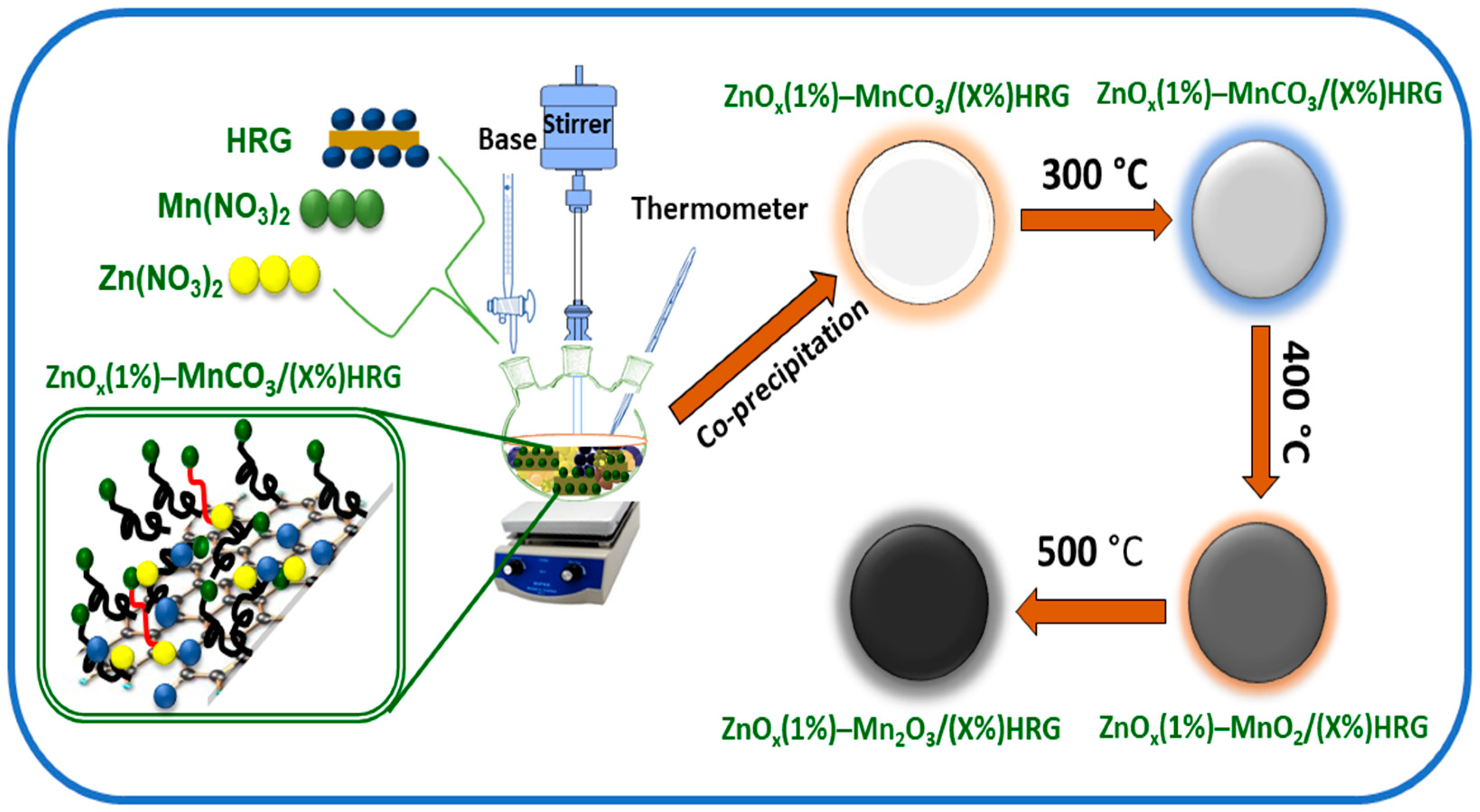
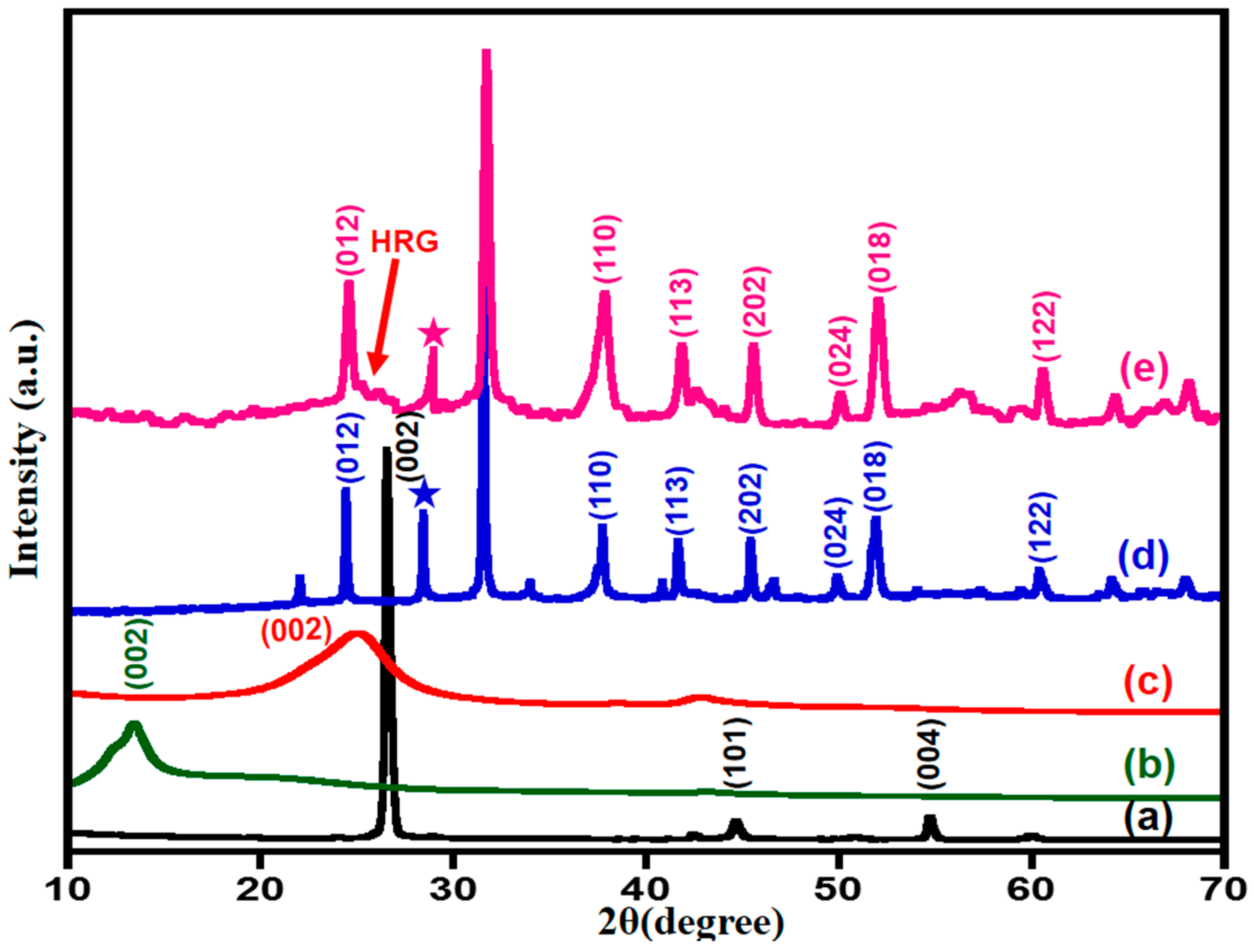
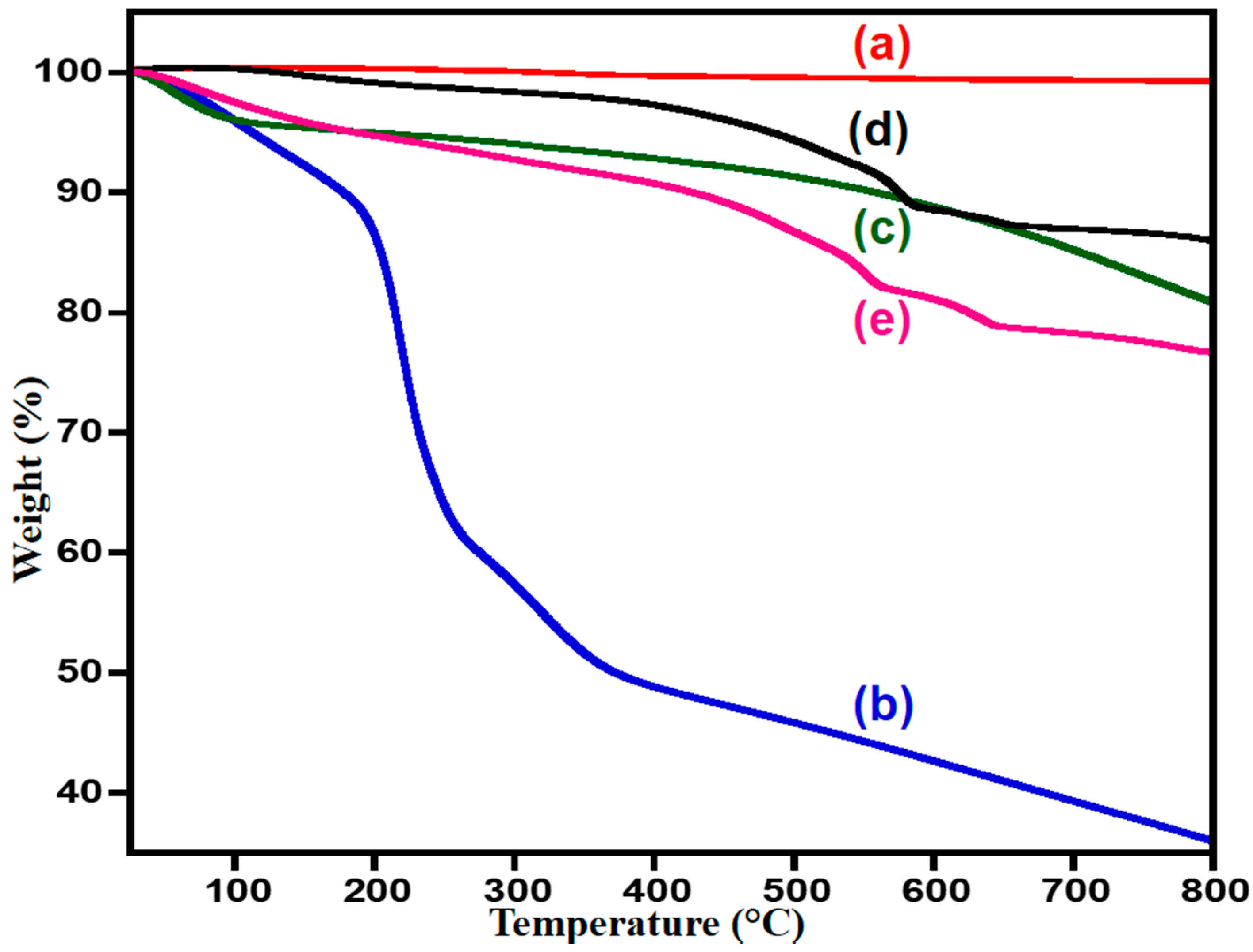
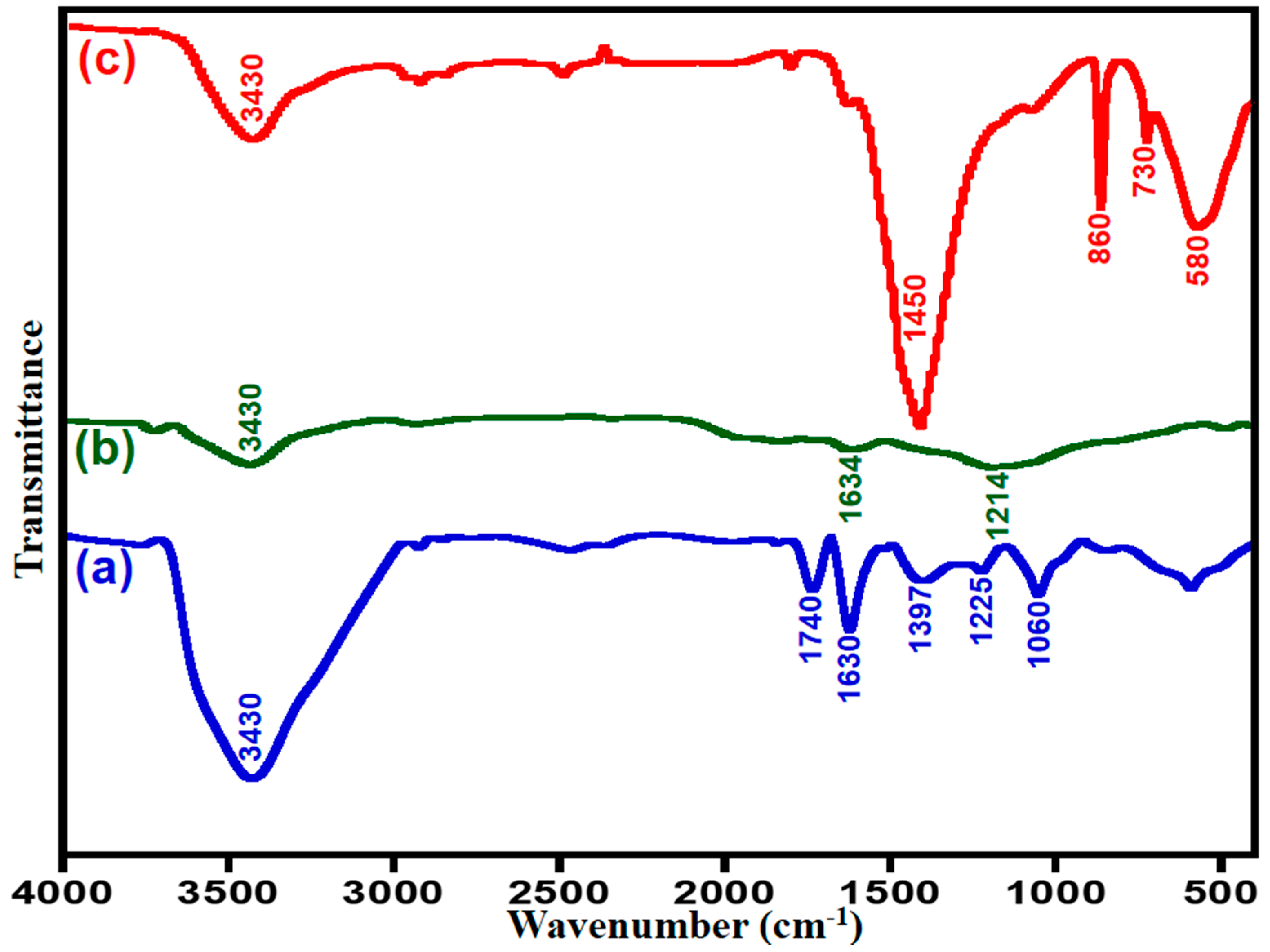
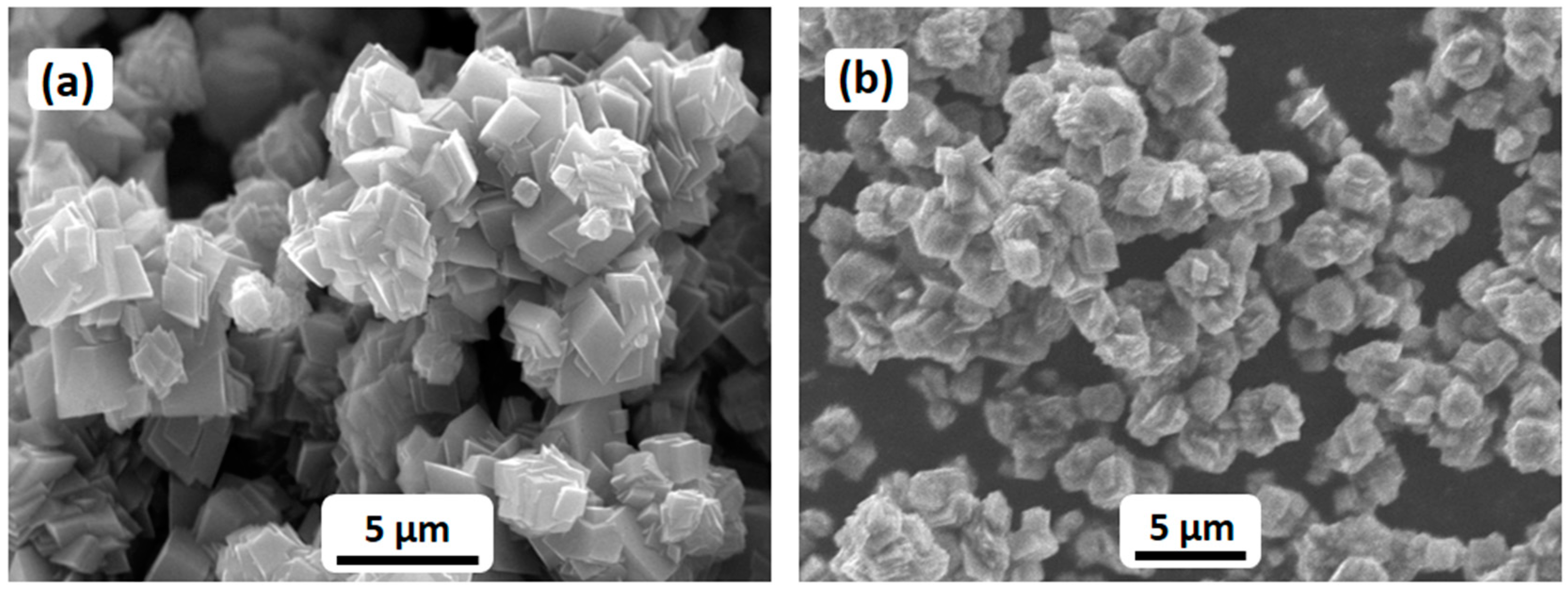
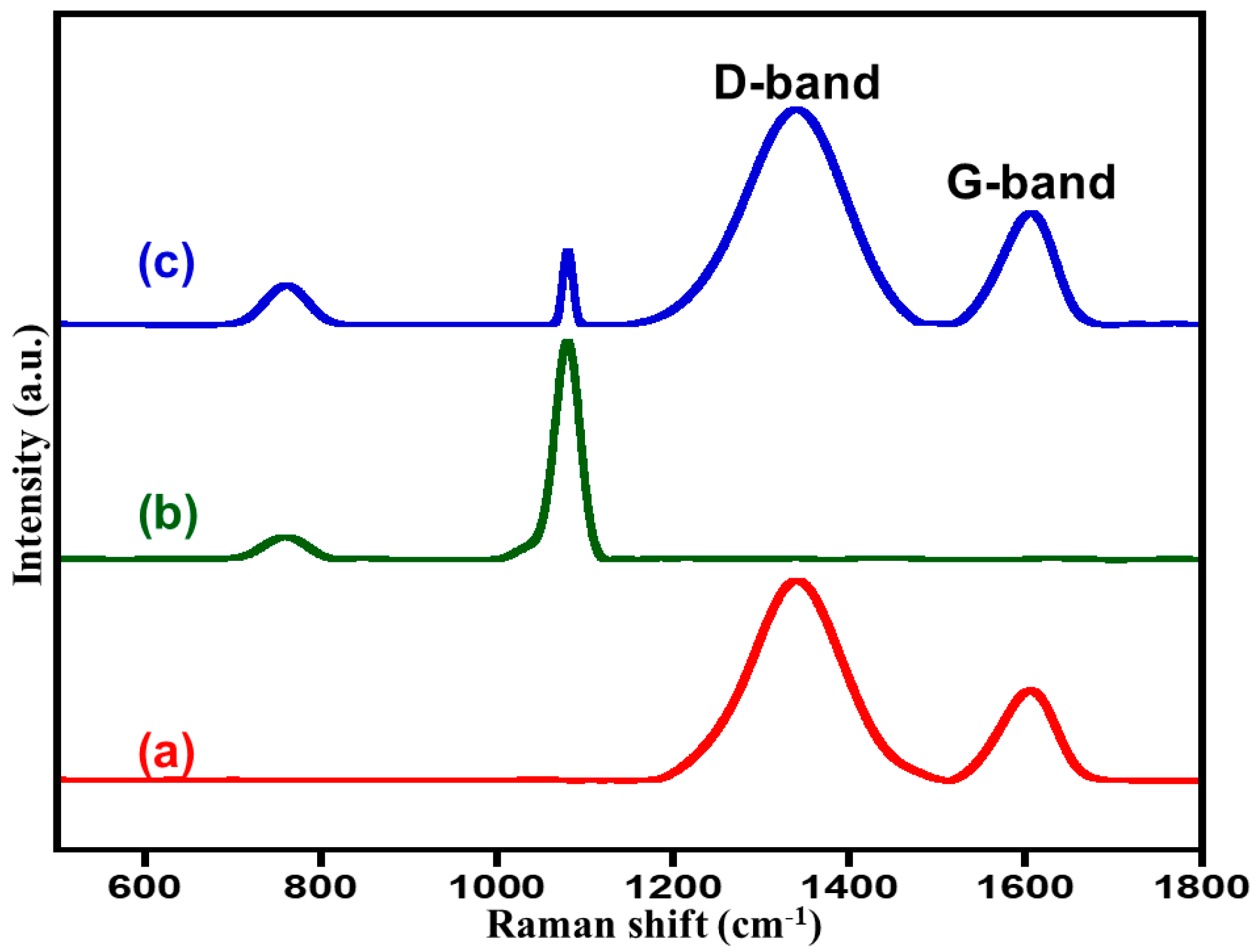
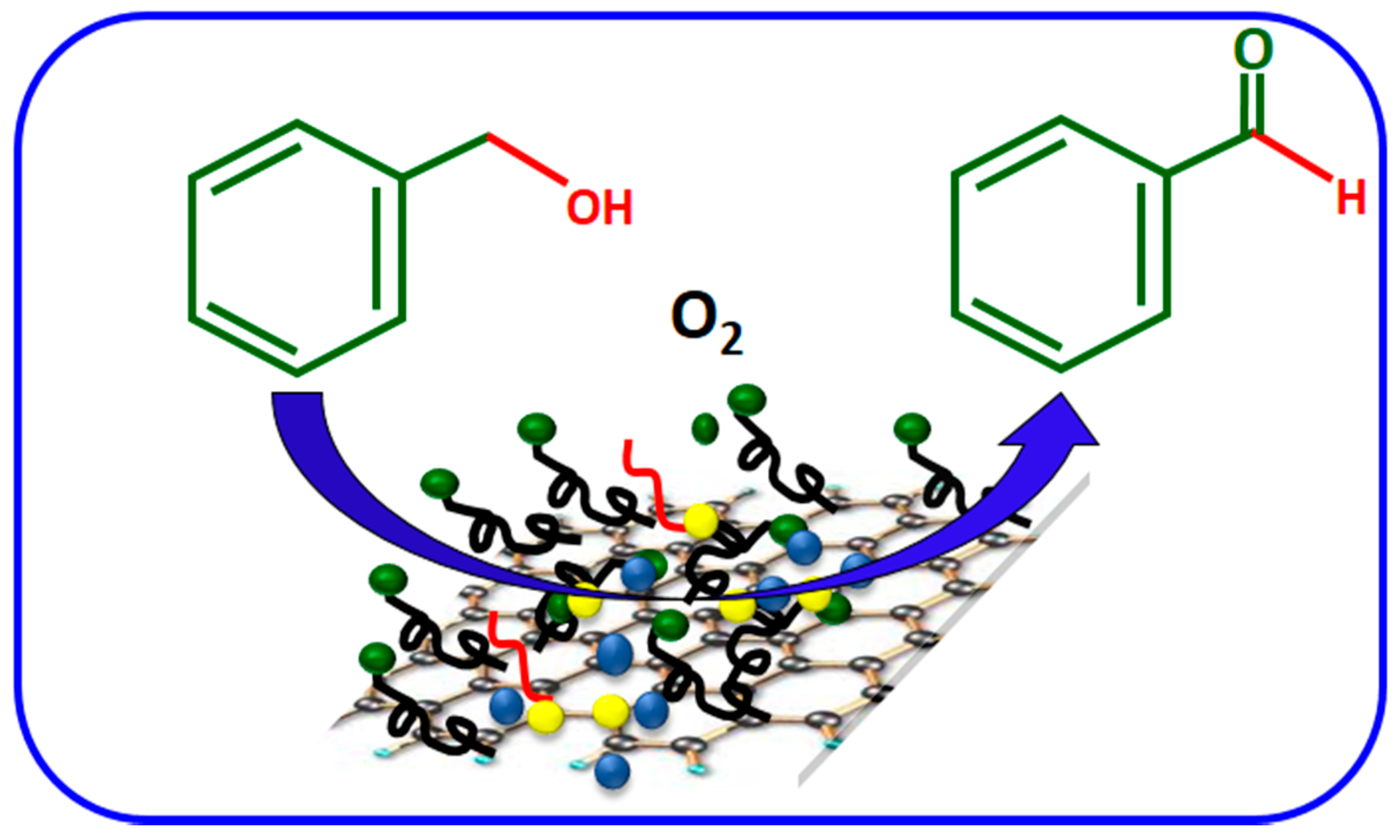
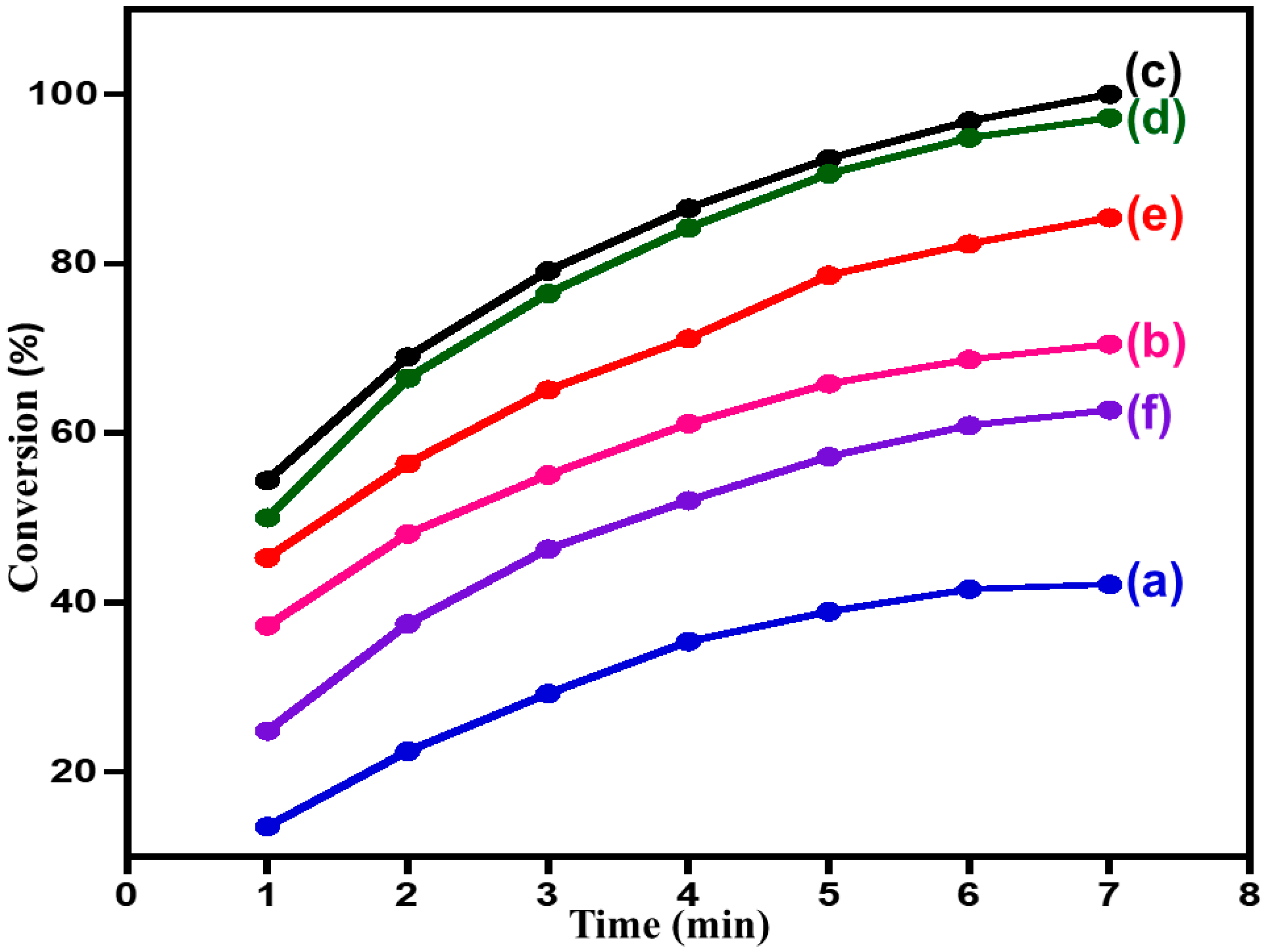
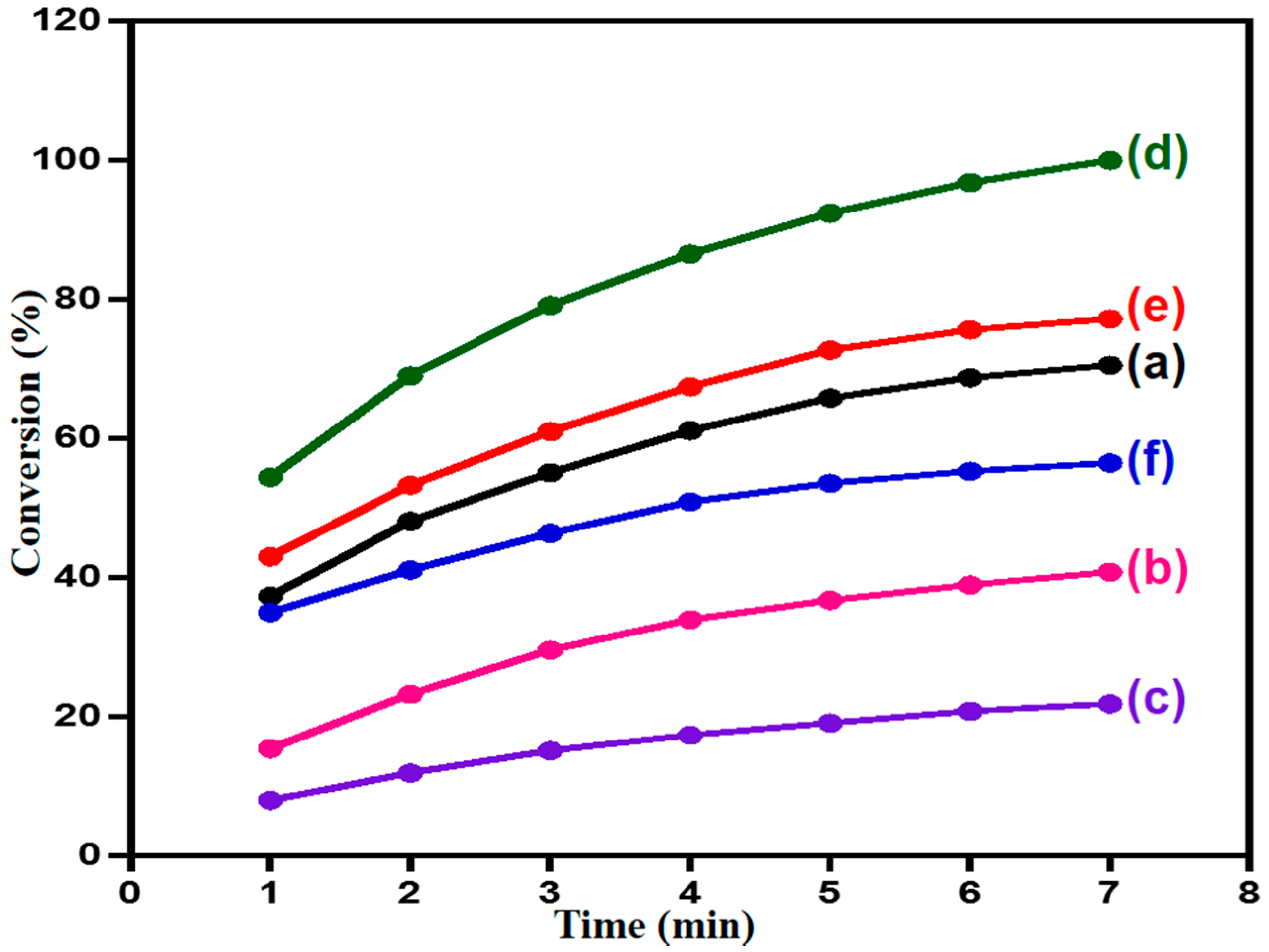

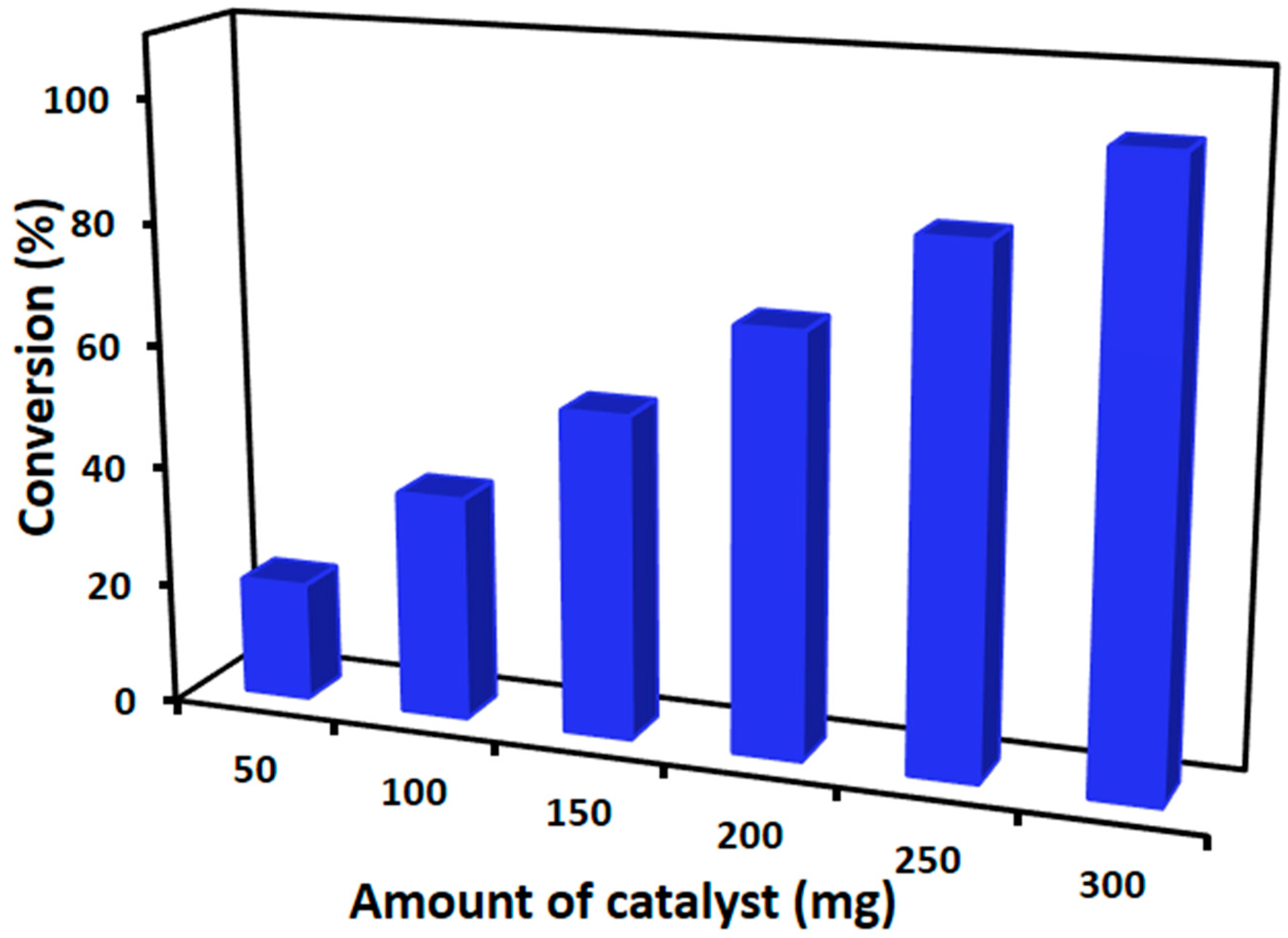
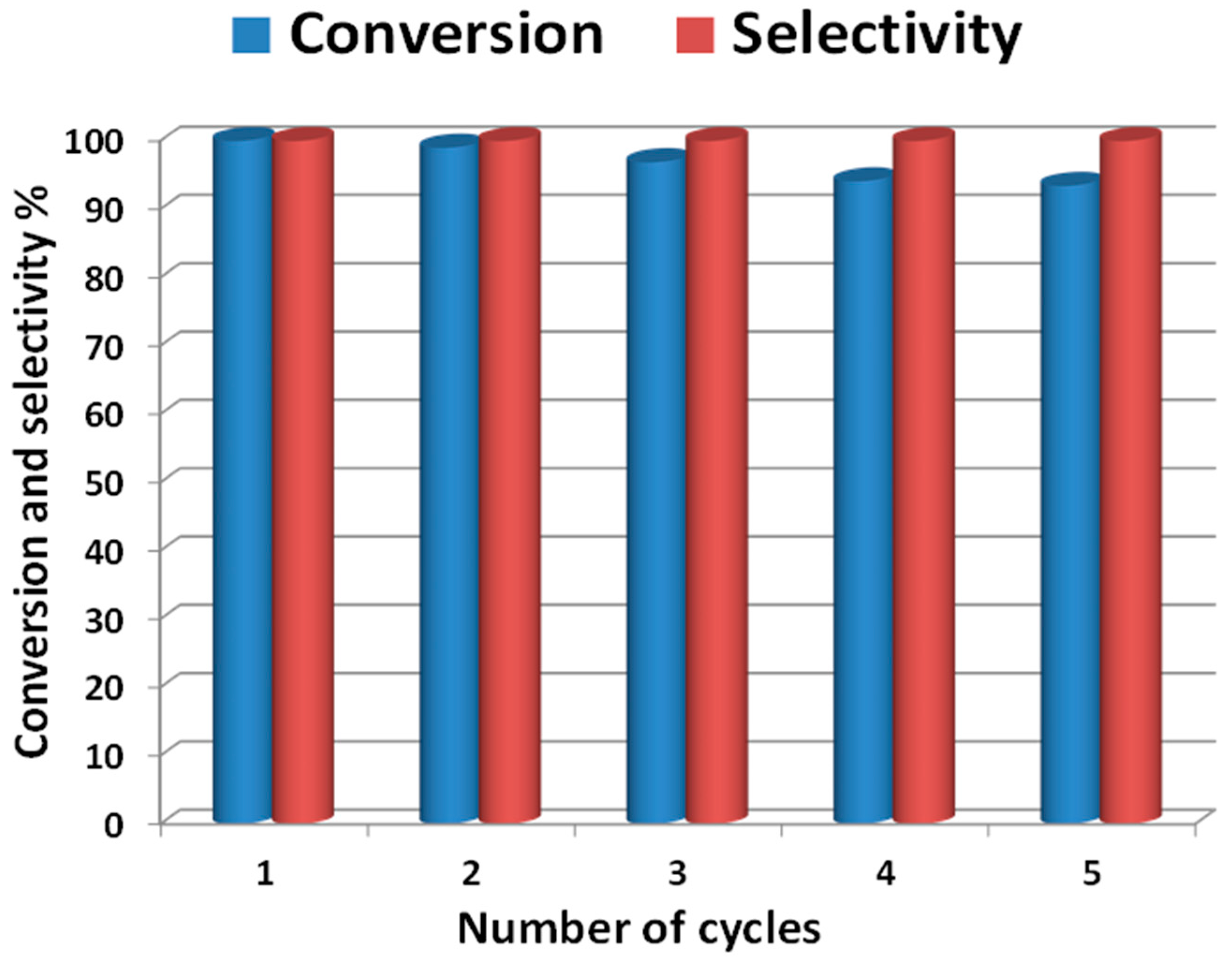
| Catalyst | Element Mass (%) | |||
|---|---|---|---|---|
| C | O | Mn | Zn | |
| ZnOx(1%)–MnCO3 | 6.30 | 23.65 | 69.04 | 1.01 |
| ZnOx(1%)–MnCO3/(1%)HRG | 26.03 | 40.33 | 32.52 | 1.12 |
| Entry | Catalyst | Conversion (%) | Specific Activity (mmol·g−1·h−1) | Selectivity (%) |
|---|---|---|---|---|
| 1 | HRG | 2.0 | 1.2 | >99 |
| 2 | MnCO3 | 42.6 | 24.3 | >99 |
| 3 | ZnOx(1%)–MnCO3 | 67.5 | 38.6 | >99 |
| 4 | ZnOx(1%)–MnCO3/(1%)HRG | 100.0 | 57.1 | >99 |
| 5 | ZnOx(1%)–MnCO3/(3%)HRG | 97.2 | 55.6 | >99 |
| 6 | ZnOx(1%)–MnCO3/(5%)HRG | 85.4 | 48.8 | >99 |
| 7 | ZnOx(1%)–MnCO3/(7%)HRG | 62.7 | 35.9 | >99 |
| Entry | Catalyst | T (°C) | Surface Area (m2·g−1) | Conversion (%) | Specific Activity (mmol·g−1·h−1) | Selectivity (%) |
|---|---|---|---|---|---|---|
| 1 | ZnOx(1%)–MnCO3 | 300 | 120.3 | 67.5 | 38.6 | >99 |
| 2 | ZnOx(1%)–MnO2 | 400 | 69.8 | 40.8 | 23.3 | >99 |
| 3 | ZnOx(1%)–Mn2O3 | 500 | 21.8 | 21.9 | 12.6 | >99 |
| 4 | ZnOx(1%)–MnCO3/(1%)HRG | 300 | 239.1 | 100.0 | 57.1 | >99 |
| 5 | ZnOx(1%)–MnO2/(1%)HRG | 400 | 179.3 | 77.2 | 44.1 | >99 |
| 6 | ZnOx(1%)–Mn2O3/(1%)HRG | 500 | 131.1 | 56.5 | 32.3 | >99 |
| Entry | Reaction Temperature (°C) | Conversion (%) | Specific Activity (mmol·g−1·h−1) | Selectivity (%) |
|---|---|---|---|---|
| 1 | 20 | 43.9 | 25.1 | >99 |
| 2 | 40 | 58.7 | 33.6 | >99 |
| 3 | 60 | 73.1 | 41.8 | >99 |
| 4 | 80 | 86.6 | 49.5 | >99 |
| 5 | 100 | 100.0 | 57.1 | >99 |
| Entry | Catalyst Amount (mg) | Conversion (%) | Specific Activity (mmol·g−1·h−1) | Substrate/Catalyst Molar Ratio | Selectivity (%) |
|---|---|---|---|---|---|
| 1 | 50 | 19.4 | 11.1 | 4.56 | >99 |
| 2 | 100 | 36.9 | 21.1 | 2.30 | >99 |
| 3 | 150 | 53.2 | 30.4 | 1.53 | >99 |
| 4 | 200 | 69.1 | 39.5 | 1.15 | >99 |
| 5 | 250 | 85.0 | 48.6 | 0.92 | >99 |
| 6 | 300 | 100.0 | 57.1 | 0.76 | >99 |
| Catalyst | Conversion (%) | Selectivity (%) | T (°C) | Time | Specific Activity (mmol·g−1·h−1) | Reference |
|---|---|---|---|---|---|---|
| ZnOx(1%)–MnCO3/(1%)HRG | 100 | >99 | 100 | 7 min | 57.1 | This work |
| ZnOx(1%)–MnCO3 | 100 | >99 | 100 | 0.33 h | 16.0 | [68] |
| TCPP/Zn-Fe2O4@ZnO | 96 | 100 | reflux | 1.5 h | 32.0 | [98] |
| Ag/ZnO | 98 | >99 | 100 | 8 h | 24.5 | [99] |
| Zn–Al LDH | 100 | 100 | reflux | 2.5 h | 8.0 | [100] |
| ZnIn2S4 | 100 | >99 | room temperature | 2 h | 6.25 | [101] |
| Au/CuO-ZnO | 94 | >99 | reflux | 1 h | 18.8 | [102] |
| ZnWO4 | 70 | 100 | 70 | 10 h | 0.7 | [103] |
| [bmim]5[PW11ZnO39] | 100 | 100 | reflux | 1.25 h | 16.0 | [104] |
| PW11Zn@AC | 100 | >99 | reflux | 0.75 h | 6.7 | [105] |
| ZnSA4 | 100 | >99 | 80 | 8 h | 2.5 | [106] |
| ZnBr2 | 100 | 91 | room temperature | 16 h | 5.3 | [107] |
| ZnPW12 | 80.1 | 89.1 | 90 | 3.5 h | 21.7 | [108] |
| ZnFe2O4 | 6.9 | 95.9 | 90 | 10 h | 0.6 | [109] |
| Zn–Cr–LDH/HD | 41.9 | 91.5 | 94 | 5 h | 8.7 | [110] |
| 1-POM(Zn) | 100 | 100 | reflux | 4.5 h | 4.4 | [111] |
| Zn/Fe2O4 | 100 | 60 | 70 | 6.5 h | 7.7 | [112] |
| Entry | Substrates | Products | Time (min) | Conversion (%) | Selectivity (%) |
|---|---|---|---|---|---|
| 1 |  |  | 7 | 100 | >99 |
| 2 |  |  | 7 | 100 | >99 |
| 3 |  |  | 7 | 100 | >99 |
| 4 |  |  | 8 | 100 | >99 |
| 5 |  |  | 8 | 100 | >99 |
| 6 |  |  | 8 | 100 | >99 |
| 7 |  |  | 10 | 100 | >99 |
| 8 |  |  | 9 | 100 | >99 |
| 9 |  |  | 9 | 100 | >99 |
| 10 |  |  | 10 | 100 | >99 |
| 11 |  |  | 10 | 100 | >99 |
| 12 |  |  | 10 | 100 | >99 |
| 13 |  |  | 11 | 100 | >99 |
| 14 |  |  | 10 | 100 | >99 |
| 15 |  |  | 12 | 100 | >99 |
| 16 |  |  | 16 | 100 | >99 |
| 17 |  |  | 11 | 100 | >99 |
| 18 |  |  | 13 | 100 | >99 |
| 19 |  |  | 15 | 100 | >99 |
| 20 |  |  | 19 | 100 | >99 |
| 21 |  |  | 100 | 100 | >99 |
© 2017 by the authors. Licensee MDPI, Basel, Switzerland. This article is an open access article distributed under the terms and conditions of the Creative Commons Attribution (CC BY) license (http://creativecommons.org/licenses/by/4.0/).
Share and Cite
Assal, M.E.; Shaik, M.R.; Kuniyil, M.; Khan, M.; Alzahrani, A.Y.; Al-Warthan, A.; Siddiqui, M.R.H.; Adil, S.F. Mixed Zinc/Manganese on Highly Reduced Graphene Oxide: A Highly Active Nanocomposite Catalyst for Aerial Oxidation of Benzylic Alcohols. Catalysts 2017, 7, 391. https://doi.org/10.3390/catal7120391
Assal ME, Shaik MR, Kuniyil M, Khan M, Alzahrani AY, Al-Warthan A, Siddiqui MRH, Adil SF. Mixed Zinc/Manganese on Highly Reduced Graphene Oxide: A Highly Active Nanocomposite Catalyst for Aerial Oxidation of Benzylic Alcohols. Catalysts. 2017; 7(12):391. https://doi.org/10.3390/catal7120391
Chicago/Turabian StyleAssal, Mohamed E., Mohammed Rafi Shaik, Mufsir Kuniyil, Mujeeb Khan, Abdulrahman Yahya Alzahrani, Abdulrahman Al-Warthan, Mohammed Rafiq H. Siddiqui, and Syed Farooq Adil. 2017. "Mixed Zinc/Manganese on Highly Reduced Graphene Oxide: A Highly Active Nanocomposite Catalyst for Aerial Oxidation of Benzylic Alcohols" Catalysts 7, no. 12: 391. https://doi.org/10.3390/catal7120391








